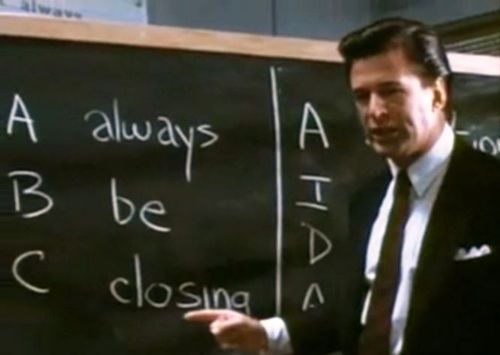50 Shades of Lead Quality: How to Build Consensus Among Sales and Marketing Teams
“The leads are weak? You’re weak.”
Two decades after Alec Baldwin used those words to berate an underperforming sales team, Glengarry Glen Ross is still a cult favorite among sales managers. The Pulitzer Prize-winning story endures, epitomizing the endless struggle between sales and marketing over lead quality. Marketing generates leads, and sales is expected to close them.
But you know what? Baldwin’s leads were weak. Today, they would be construed as little more than a list of locals in high income brackets. Unfortunately, some leads generated by corporate marketing departments these days are not much better. That’s why enterprise companies work so hard to define what a lead actually is.
The trouble is that few marketers can even agree on that question. Recently, BtoB Magazine’s recent study, 2012 Lead Generation: A Fundamental Flourishes in the Digital Era, surveyed over 600 marketers to find out what they thought.
Only 73% could agree that a prospect specifically requesting a sales contact could be defined as a lead, a stat that will seem crazy to the remaining 27% of most marketers.
Only 47% agreed that a prospect that has contacted an organization through more than one channel could be construed as a lead, while a prospect qualified by a telemarketing team rated at just 35%.
With this much disagreement among marketers, it’s no wonder that it’s so difficult to get sales and marketing on the same page.
Lead Scoring and Marketing Qualified Leads
A major development in marketing theory has been the concept of lead scoring, which is a prevalent selling point of many marketing automation software products. Even if most companies still aren’t doing this, the associated thought leadership published by the likes of Eloqua and Marketo has been highly influential within enterprise business communities. The concept is that through close tracking, a number of different prospect actions may add up to qualify that individual as a Marketing Qualified Lead (MQL), which is loosely defined here as a lead that is both ready to be contacted by sales, and also worthy of being contacted by sales.
For example, let’s imagine that we decided to score prospects on a scale of zero to 100, with anything above 20 being a “lead,” and anything above 60 being an MQL, or “sales-ready” lead. If someone downloads and installs your free product, they might get assigned 5 points, but they are still not a lead. If they then access your eBook, they might get another 10 points, but again, they’re still not a lead. But if they then visit the product pages on your website, they would get 15 points, bringing their point total to 30. At this point, they are technically over our predetermined threshold, and are therefore a lead. A sophisticated product like Marketo would trigger some sort of action, which could include adding them to a nurturing program, or even contact from a sales rep.
This exercise might seem like masochism to the uninitiated marketer. However, the methodology has been successful in a great number of companies, particularly those in B2B, with a complex sales story. Lead scoring is a winning formula that builds theoretical consensus between sales and marketing teams, even while rendering it fundamentally impossible to agree that any single action taken by a prospect is a home run.
Using Real-Time Contextual Data to Help Qualify Leads
While creating Revenue.io, the business team had a bright idea – let sales reps, especially those speaking with prospects, decide whether a prospect was a lead, even if they’re right in the middle of a call. The theory was that sales reps deserved an “override” button of sorts that was easy to use, even if they were away from their desks.
While using our Revenue.io Free for Salesforce app, sales reps can qualify a lead with the tap of a button while speaking to a prospect on their iPad or iPad Mini. Keep in mind that they’re not simply making this judgment based on the audio call. They’re also experiencing, in real time, the prospect’s CRM history, social media feeds, past call ratings, and in the premium versions we’re beginning to test around the office, information about the referring marketing campaign that led to the call.
We feel that empowering sales reps with this type of data – plus lead qualification capability on their mobile device – is a lot better than sitting in a hot, crowded room arguing about how strong or weak the leads are.
Although, to be honest, that can be fun too. In case you haven’t seen it, here’s the great Glengarry parody produced by Salesforce.com. And here’s the original scene with Alec Baldwin.
2020 update: This post contains legacy content regarding Revenue.io features. For the most recent up-to-date information about Revenue.io, please check out our amazing solutions at www.revenue.io

